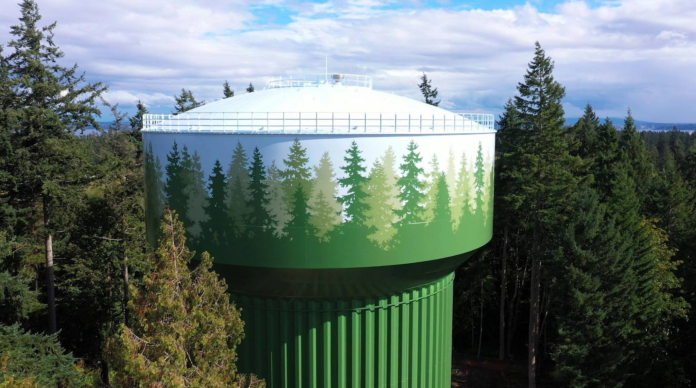No river runs perfectly straight; there’s no straightforward answer to groundwater management on Bainbridge Island, per a peer review from consulting firm Keta Waters.
BI city councilmembers heard results from a peer review of the city’s Groundwater Management Plan by Keta Waters, a father-son consulting firm duo who specialize in water resources and environmental concerns, at the Oct. 21 council meeting.
Joel and Adam Massmann shared a high-level summary of their recommendations to council, which emphasize conservation and water resilience over far-reaching climate-change scenario planning.
The Keta team found that the GWMP’s focus on modeling groundwater development and future climate scenarios provides little actionable guidance on how to manage water use in the future, due to their inherent uncertainty. Additionally, the city’s current data about its available groundwater resources “do not provide definitive evidence” whether current water use is sustainable or unsustainable.
Therefore, encouraging water conservation and surface water management is about the best bang-for-buck the city can get, they explained.
“What I think the elephant in the room for our community is, ‘What does that mean for our plans for growth, and how does that recharge and or conservation relate to population growth? Can we accommodate, in a smart way, more population growth if we pursue these other modes?’” asked councilmember Leslie Schneider.
It depends on how aggressively the city decides to pursue water conservation, Joel Massmann responded.
“As far as the groundwater model goes, we tried to provide some constructive criticism about the modeling work that’s been done […] Some of the difficulties with that model influence our recommendations about moving forward with doing what you can do about what you know, and what you know is that if you can conserve more water and if you can increase the recharge, you’re going to be better off,” he said. “No matter how much modeling you do, there’s still going to be lots of uncertainties, and you probably still won’t know if your current and future production is going to be sustainable or not. The best thing to do, in my estimation, is to continue the monitoring you’ve been doing, maybe beef it up if you can, and do what you can to control both the inflow and outflow from that system.”
A key unknown, Joel Massmann noted, was the lack of information in the GWMP about groundwater recharge rates.
Per the Keta team’s review, the existing method in the GWMP of recording aquifer recharge on BI is “crude” and “flawed.”
Fresh groundwater on the island leaves the aquifer through withdrawal by wells, as well as discharge into streams, wetlands and bodies of saltwater. A sustainable balance would account for human needs as well as the ecosystems that depend on groundwater: where the amount of naturally-occurring outflow, plus the amount drawn by wells, equals the inflow of freshwater from precipitation.
There is no way to determine exactly how much water returns to an aquifer in a given year, but with multiple extensive surface model studies that reflect land use and environmental conditions, a range of possible annual recharge rates can be determined. However, it’s an inexact science; each study takes so many environmental factors into account that it must make simplifications and assumptions, which can introduce error and uncertainty.
For example, on Vashon Island, the estimated annual recharge rate is anywhere between 5-17 inches/year. In contrast, BI’s GWMP uses a single value for its recharge rate under current conditions — 9.3 inches/year — which differs from previous estimates without explanation, and “is derived from a method that is even more crude than the assumptions and simplifications described [in land surface modeling].”
“Because of these flaws, the estimated recharge in the current GWMP is unlikely to be correct, fails to responsibly capture the uncertainty inherent in estimating recharge, and renders the model into which it is fed fundamentally incapable of quantifying how changes in land-use, precipitation, temperature, radiation or atmospheric aridity may impact recharge,” the Keta team wrote in their peer review.
While water inflow is difficult to quantify, outflow can be monitored through well withdrawal and water usage rates, the Keta team explained at the meeting, which could be a starting point for how to shape the city’s approach to water use and allocation.
“One low-hanging fruit is to say, ‘These systems that are using very little water, what are they doing that’s working? And these systems that are using a lot of water, where is that water going, and why are they using so much water?’” said Adam Massmann. “If you’re able to bring the high-use systems down to the low-use systems, you can increase the resilience of the system right there.”
Without quantifiable knowledge of the state of the aquifer, the best way to make policy decisions about the use of water on Bainbridge is to push for conservation, added Joel Massmann. But it’s not just Bainbridge leaders who are making choices about water.
Mayor Ashley Mathews noted that the south end of BI uses the most water out of all of the Kitsap Public Utility District’s service area. She asked the Keta team what city lawmakers’ first step should be to encourage production.
Adam Massmann responded, saying the city should focus on conservation, but to keep in mind that other water users could impact available resources.
“One thing to be concerned about is, KPUD, in some of their recent work, has assumed pretty large increases in production. And getting back to these figures, how close the margins are between the water withdrawals and the recharge refilling the system, that having such an aggressive assumed growth and production for their systems could create issues for the city of Bainbridge Island and for all the permit-exempt well users that live on the island,” he said.




